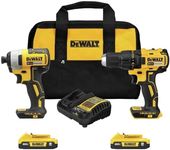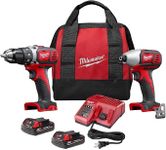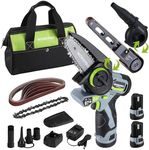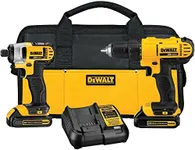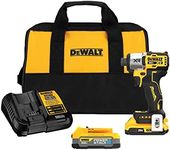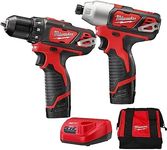Buying Guide for the Best Impact Drill Driver
Choosing the right impact drill driver can make a significant difference in the efficiency and ease of your projects. Whether you're a professional contractor or a DIY enthusiast, understanding the key specifications of an impact drill driver will help you select the best tool for your needs. Here are the main specs to consider and how to navigate them.Power (Voltage)The power of an impact drill driver is typically measured in volts (V). This spec indicates the strength of the motor and its ability to handle tough tasks. Lower voltage models (12V) are suitable for light-duty tasks like assembling furniture or drilling into soft materials. Mid-range models (18V-20V) offer a balance of power and portability, making them ideal for general home improvement projects. Higher voltage models (24V and above) are designed for heavy-duty tasks, such as drilling into concrete or metal. Choose the voltage based on the type of projects you plan to undertake.
TorqueTorque is the rotational force that the drill driver can apply. It is measured in inch-pounds (in-lbs) or Newton-meters (Nm). Higher torque means the tool can drive screws and drill holes more effectively, especially in hard materials. For light tasks, a torque of around 200 in-lbs is sufficient. For general use, look for a torque range of 300-500 in-lbs. For heavy-duty applications, a torque of 600 in-lbs or more is recommended. Consider the materials you will be working with and the type of tasks to determine the appropriate torque.
Speed (RPM)Speed, measured in revolutions per minute (RPM), indicates how fast the drill bit or driver bit spins. Most impact drill drivers have variable speed settings, allowing you to adjust the speed based on the task. Lower speeds (0-500 RPM) are ideal for driving screws and working with delicate materials. Higher speeds (up to 3000 RPM) are better for drilling holes and working with harder materials. A model with multiple speed settings provides greater versatility for different tasks.
Battery LifeBattery life is crucial for cordless impact drill drivers. It determines how long you can use the tool before needing to recharge. Battery capacity is measured in ampere-hours (Ah). A higher Ah rating means longer battery life. For occasional use, a 1.5-2.0 Ah battery may suffice. For regular or heavy use, consider a battery with 3.0 Ah or more. Additionally, look for models with fast-charging capabilities to minimize downtime.
Weight and ErgonomicsThe weight and ergonomics of an impact drill driver affect user comfort and fatigue, especially during extended use. Lighter models (around 2-3 pounds) are easier to handle and maneuver, making them suitable for overhead or one-handed tasks. Heavier models (4 pounds and above) may offer more power but can be tiring to use for long periods. Ergonomic features like a comfortable grip, balanced design, and anti-vibration technology can enhance user experience. Consider how long and how often you will use the tool to determine the right balance of weight and ergonomics.
Chuck SizeThe chuck size determines the maximum diameter of the drill bit or driver bit that the tool can accommodate. Common chuck sizes are 1/4 inch, 3/8 inch, and 1/2 inch. A 1/4 inch chuck is suitable for light-duty tasks and smaller bits. A 3/8 inch chuck offers more versatility for general use. A 1/2 inch chuck is ideal for heavy-duty tasks and larger bits. Choose the chuck size based on the types of bits you plan to use and the nature of your projects.
Impact Rate (IPM)Impact rate, measured in impacts per minute (IPM), indicates how many times the hammer mechanism strikes per minute. A higher impact rate means the tool can drive screws and drill holes more quickly and efficiently. For light tasks, an impact rate of around 2000-3000 IPM is sufficient. For general use, look for an impact rate of 3000-4000 IPM. For heavy-duty applications, an impact rate of 4000 IPM or more is recommended. Consider the speed and efficiency you need for your projects to determine the appropriate impact rate.



